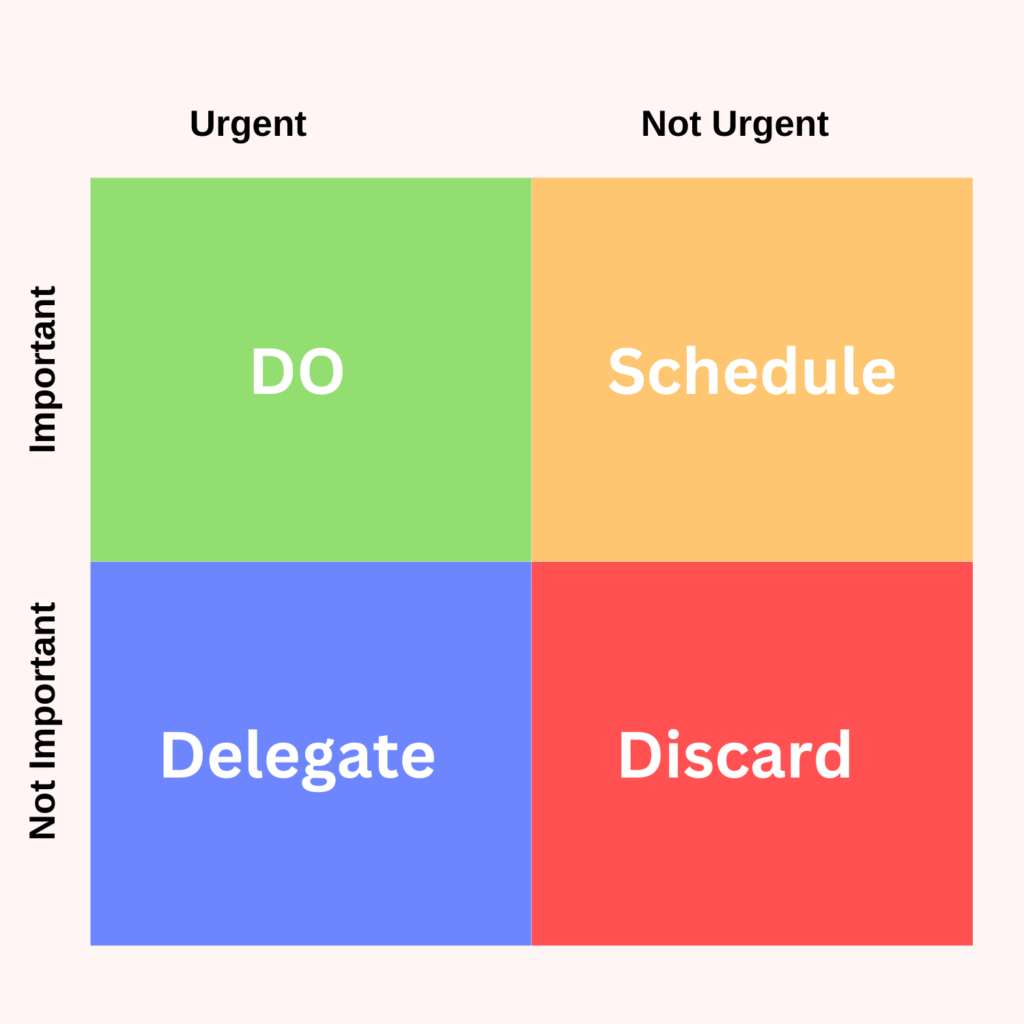We all have those days where our to-do list seems to have a life of its own, doesn’t it? Notifications ping, emails flood in, deadlines loom, and suddenly, everything feels equally urgent. So, how do you decide what really needs your attention and what can (and should) wait? This is where understanding the “Urgent vs. Important” matrix, famously popularized by Dwight D. Eisenhower, can transform how you handle your daily tasks.
Let’s dive into the magic behind the Urgent vs. Important Quadrants. With a little insight into how these categories work, you’ll learn not only how to stay on top of your day-to-day tasks but also how to give those important (but often overlooked) goals the attention they deserve.
The Four Quadrants Explained

The Urgent vs. Important Matrix breaks tasks into four simple categories, or “quadrants,” that help you prioritize and manage them effectively. Here’s a quick look at each one:
- Quadrant 1: Urgent and Important
These are tasks that require immediate action and have significant consequences if left undone. Think of crises, impending deadlines, and last-minute preparations. - Quadrant 2: Important but Not Urgent
These tasks are crucial for long-term success but don’t scream for your immediate attention. Examples include planning, strategizing, personal growth, and building relationships. These tasks are often sacrificed in the whirlwind of day-to-day “urgent” matters, but they’re where the real growth happens. - Quadrant 3: Urgent but Not Important
These are tasks that demand immediate attention but don’t contribute meaningfully to your goals. Common examples include responding to unimportant emails or dealing with interruptions that seem pressing but are ultimately trivial. - Quadrant 4: Not Urgent and Not Important
This quadrant is where time-wasters live. Scrolling social media, excessive Netflix binges, and unproductive meetings that could be emails—these are activities that don’t move the needle forward and might even set you back.
The Secret Quadrant: The Importance of Quadrant 2
Now, here’s the twist: Quadrant 2, the “Important but Not Urgent” category, is where the magic happens, yet it’s also the most neglected. Why? Because these tasks lack the pressing urgency that drives action in Quadrants 1 and 3, they’re easily postponed for “later.” Unfortunately, later doesn’t always arrive.
By the time we’re drowning in fires from Quadrants 1 and 3, these meaningful tasks are often left undone, and we’re left wondering why we’re making no real progress toward our bigger goals.
How to Categorize Your Daily Tasks: Practical Steps
Categorizing tasks into these quadrants is easier than you think, but it does require some self-reflection and honesty. Here are some steps to make it work for you:
- List Out Your Tasks
Start by writing down everything you think you need to accomplish today. Don’t worry about categorizing them just yet—just get them out of your head and onto paper (or a digital list, if you prefer). - Assign Each Task to a Quadrant
Now that you have your list, go through each task and decide which quadrant it fits into. This requires you to ask yourself two questions for each task:- “Is this urgent?”
- “Is this important?”
- Prioritize Quadrant 2
It’s easy to ignore Quadrant 2 tasks because they’re not urgent. But remember, these are the tasks that often hold the key to your long-term success and well-being. Make it a point to carve out dedicated time to focus on these activities, even if they don’t demand your immediate attention. - Use Time Blocking
Schedule specific blocks of time for tasks in Quadrant 2. This could be as simple as setting aside 30 minutes each day for personal development, strategic planning, or goal setting. By deliberately making time for these tasks, you ensure they don’t slip through the cracks. - Reduce Tasks in Quadrants 3 and 4
Quadrant 3 tasks might feel urgent, but they rarely contribute to your goals. Aim to delegate these when possible or set boundaries to minimize interruptions. For tasks in Quadrant 4, recognize them as time-wasters, and consciously limit them to break times or cut them out altogether.
The Trap: How Important Tasks Flip Aside
It’s easy to let those important, non-urgent tasks fade into the background, especially when they don’t have a specific deadline. Over time, though, neglecting these tasks can lead to stress, missed opportunities, and burnout.
Imagine you’re trying to improve your health, for example. Meal prepping, exercise, and sleep might seem like tasks that can be postponed. But if you continually put them off, you’ll start feeling the consequences—both physically and mentally.
The same goes for professional development. Suppose you want to learn a new skill that could help advance your career. If you’re constantly delaying this because it doesn’t feel urgent, you might miss out on career opportunities that require that skill set.
Putting It All Together: Making the Matrix Work for You
Knowing the matrix is one thing, but applying it is where the real impact lies. Here’s a quick recap to keep in mind as you categorize your daily tasks:
- Handle Quadrant 1 tasks immediately since they have a high impact and are time-sensitive.
- Dedicate regular time to Quadrant 2 tasks to ensure they don’t get overshadowed by the urgent tasks.
- Delegate or limit Quadrant 3 tasks to minimize interruptions that steal your time.
- Cut down on Quadrant 4 tasks by recognizing when you’re falling into time-wasting habits.
A good rule of thumb? Try to spend most of your time on Quadrants 1 and 2, with a strong emphasis on 2. Over time, you’ll notice that fewer crises arise (Quadrant 1) as you proactively take care of important matters.
Conclusion: Small Shifts, Big Payoffs
Mastering the art of prioritizing between urgent and important tasks can feel like a superpower. By consciously choosing to invest in Quadrant 2 activities, you’re actually setting yourself up for less stress, better results, and a more intentional path to your goals.
So next time you’re facing an overwhelming to-do list, take a step back. Look at each item with the “urgent vs. important” lens, and decide where it truly belongs. With practice, prioritizing will become second nature, and you’ll find yourself not just managing your time, but mastering it.
